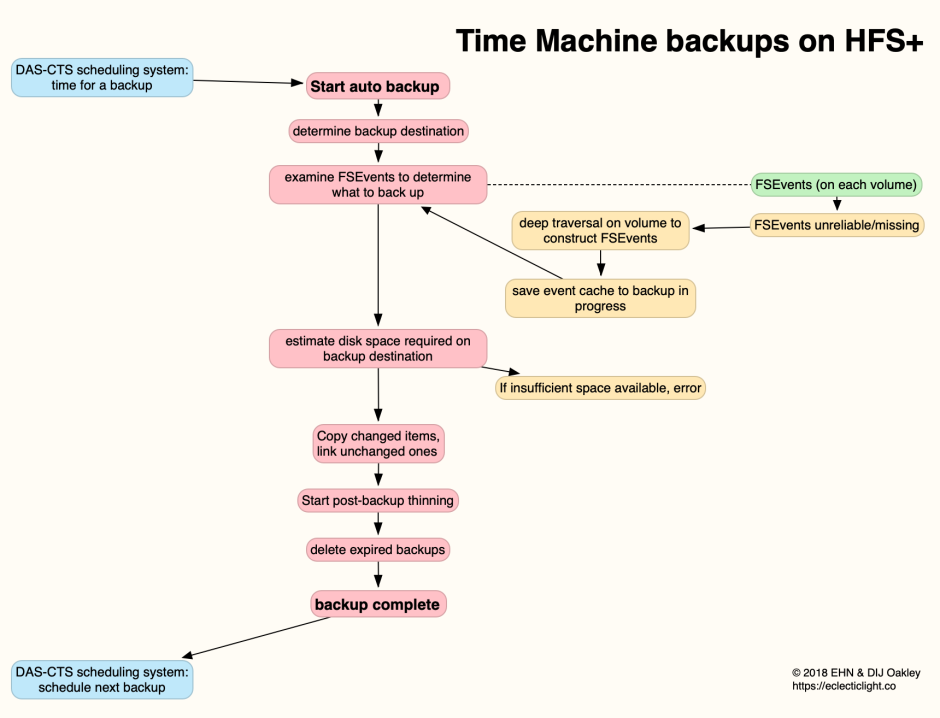Speculation was rife among users, rather than developers, that last June’s WWDC might have brought announcement of a major update to Time Machine coming in Catalina. Now that all Macs running Mojave have to boot from APFS, and with Catalina’s additional conjuring trick of a read-only APFS system volume, for many systems now the only drives still using HFS+ are those for Time Machine’s backups. So why hasn’t Apple fixed Time Machine so that it can back up to APFS yet?
Time Machine isn’t just popular because it’s bundled with macOS, but also because it integrates with so many features of macOS.

It uses hard links both for files and directories to create the impression that each backup is a complete copy of everything on a volume. It provides a familiar Finder-like interface to all your backups, which is also used by the Version Browser, which integrates with its backups too. Backups are indexed for Spotlight search, ensuring that Spotlight can see what’s in your backups and include them in searches. That metadata indexing is performed in the background once backing up has been completed, and doesn’t slow the backup process. Backups are also integrated into other system functions for recovery and migration.
When Apple was designing APFS it wasn’t accidental that support for directory hard links wasn’t included. Time Machine’s reliance on hard links was a brilliant move back in the early days of Mac OS X when 250 GB hard disks were thought to be massive. It’s not uncommon these days for backups to contain many millions of hard links, and their proliferation in backups isn’t a good way to maintain a reliable file system.
Another reliance that Apple was keen to end was that on the system FSEvents database for determining what needed to be backed up each time. Users have been finding that ‘deep traversal scans’, required when FSEvents couldn’t deliver the information needed, have been getting more frequent. Not only did APFS need snapshots as a quick way to restore a volume to a previous point in time, but it needed snapshot deltas, to detail exactly what had changed.

What we now have in Mojave is a sleeker and better Time Machine, but there’s still a long way to go before it will work well backing up to APFS volumes.
In Catalina, the engine needed seems largely complete, according to the presentations at WWDC, with Apple Software Restore (ASR) now able to use snapshot deltas and perform partial restores from backups. But the rest of the integration is still going to take time, and that’s inevitable because it involves changes in other parts of macOS.
Take the problem of Spotlight search integration, for example. At present, mdworker indexer daemons don’t index the contents of snapshots, as far as we know. It’s only once a backup is complete that they set to work updating the backup volume’s metadata indexes. This system needs to be changed to work with the new restorable delta images which asr might produce during a backup.
There’s a great deal more work to be done for the user interface too. The existing Time Machine app benefits greatly from the structure of HFS+ backups with all their hard links. If those are to be dispensed with, a new illusion has to be created for the user. This also has to integrate with Version Management, where the contents of backups are included with saved versions of a document.
Of course, Apple could easily devote the engineering investment to get this completed more quickly, although throwing lots of money and engineers at software projects often isn’t either efficient or successful. But who is really ready to back up to APFS just now?
Most users currently back up to external hard disks, which might cost around £/$/€ 150 for an 8 TB model. Go up market a bit, and an 8 TB hardware RAID would cost you upwards of £/$/€ 400. An external 7.68 TB SSD, if you can find one, is likely to cost you around £/$/€ 1500, and the same capacity in a RAID system isn’t going to be any cheaper.
Many Mojave users know that APFS works fine on hard drives, but it’s designed to get the most out of SSDs. Given the choice of running HFS+ or APFS on an external hard disk, I think that I’d probably still prefer HFS+. For an external backup drive to really shine in APFS, it would need a true Thunderbolt 3 interface to SSDs, and that makes it a small and expensive field at present.
I’m sure that Time Machine 2 is on its way, and heavy hints at WWDC about snapshot deltas and ASR point the way. But I don’t think that many users would currently want to use it, if it required the backup disk to be APFS. But next year this may well change.
